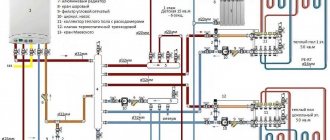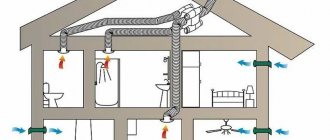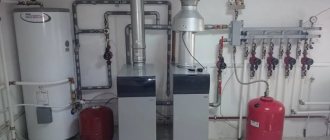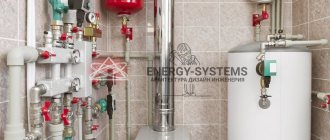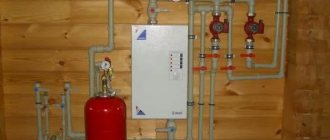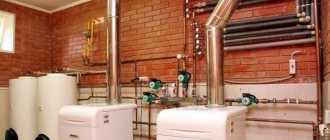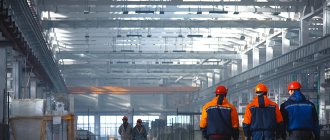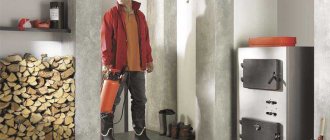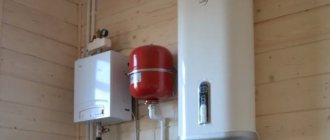Ventilation in the boiler room is a mandatory requirement for the safe use of gas heating appliances. Failure to comply is associated with a number of problems, both administrative and an increased likelihood of an emergency.
Since the accumulation of carbon monoxide and other combustion products poses a danger not only to the direct owner of the gas boiler, the compliance of the ventilation system with SNiP standards is carefully checked by gas services at the stage of equipment acceptance.
In turn, using a boiler without the appropriate permission can lead not only to administrative, but in some cases to criminal liability.
Carbon monoxide is very dangerous, so the ventilation system of a gas boiler room in a private house must work flawlessly Source tula.sm-news.ru
Types of ventilation
There are only two main types of ventilation: forced and natural, and in some cases combined ventilation is used, which is sometimes classified as a separate category.
As the names indicate, the first type of ventilation uses forced air supply, for which air pumps or fans are used. In the second case, the air flow occurs due to the difference in its temperature and pressure - inside and outside the room. To ensure air exchange, it is enough to position the ventilation holes correctly. Also, some of the air can enter the room through natural openings - for example, cracks under doors.
If there is such a possibility, then it is most profitable to use a combined system - while natural ventilation copes with air exchange, forced ventilation is in standby mode.
Natural ventilation
If the air volume changes three times per hour, then in a standard six-meter (in height) room you can get by with natural air exchange.
For reference! The standards were developed for all boiler houses - industrial and domestic, so the standard was taken to be a room large enough for a private home.
When the ceiling is lowered by every meter, you will have to increase the air circulation by at least 25%. Plus, in any case, you should design the air exchange with some margin.
Scheme of operation of the ventilation system in the boiler room of a private house Source pew.ledikycora.ru.net
The scheme is extremely simple - opposite the boiler, in the door or wall, there is a ventilation inlet (the diameter depends on the power of the boiler), which is located no higher than its working area. The second, the exhaust hole is arranged above the boiler; usually an air duct with a check valve is attached to it (so that the hood only works in one direction) and an “umbrella” on the outside (so that the pipe does not flood).
The distance between the “input” and “exit” of air in the room should be as large as possible to ensure better draft.
Disadvantages of natural ventilation:
- Dependence on weather conditions . It is necessary to protect air ducts from external environmental influences.
- Difficulty in accurately calculating air conditioning. Depending on the direction and strength of the wind, different volumes of air can enter the room.
- It is very difficult to design one ventilation system for several rooms - so that one pipe passes through all the rooms. Mostly, the exit from each room is made directly to the street.
Forced ventilation system or, more simply, an exhaust hood for a boiler in a private house Source m.yukle.mobi
See also: Contacts of companies that specialize in ventilation and air conditioning.
Forced ventilation
Forced air supply is carried out by so-called “mechanical devices”, that is, fans. This type of air exchange arrangement is convenient for two reasons :
- It becomes possible to install climate control equipment , with heaters and filters, which will clean and heat the incoming air;
- It also becomes possible to turn on the system only at the necessary moments , which will save energy by turning it on, for example, only when the boiler is operating.
The disadvantages of forced ventilation are as follows:
- Cost - first of all, such a system will cost more than natural ventilation;
- In some cases, noise – for example, when installing climate control equipment with air conditioning;
- Choosing equipment without proper preparation can be fraught with a safety violation: in particular, for gas boiler houses it is important to have fire-resistant equipment.
The heating system is a rather complex set of equipment, so its selection and adjustment should be carried out by professionals Source stroimdom.com.ua
Expert advice
Tips from experts on equipment selection and installation:
- If you choose a strong and durable hood, take a closer look at models made of stainless steel and aluminum.
- If you choose a fan with high power and too much air flow, this may lead to blockage of the air duct. This will cause all the smell and smoke to spread to other rooms.
- Ventilation ducts and air ducts should be cleaned periodically. Please consider this before choosing.
- If the kitchen is more than 15 square meters, two ventilation ducts are installed. One will serve to fill with fresh air, and the second will serve for exhaust.
- It is important to consider that the decorative grille and valve sometimes reduce the speed of air movement by 10 times. In this regard, do not opt for a device with minimal power.
- When choosing a hood, take into account the volume of air that needs to be purified within an hour. We take the volume of the kitchen, multiplying the area by the height, multiplying by the air exchange rate (12) and multiplying by 1.3 (minimum reserve coefficient). This way you will get the performance of the hood.
- When determining the dimensions of the hood, take into account that the area of the air intake should correspond to the area of the working surface of the stove, or better yet, exceed it.
- How to take into account a comfortable noise level? 20 decibels is like the rustling of pages, 25-35 is about like a loud whisper, 50 dB is the noise level like during a normal conversation, 89-90 is like the noise of a passing motorcycle or a hair dryer when drying, 110 is like how it works drill or hammer drill, 130 dB is already exceeding the pain limit.
- When choosing a hood, the question may arise: do you need lighting? They are automatic, touch-activated or with a button. Experts believe that the presence or absence of lighting does not in any way affect the main tasks of the hood, so when choosing, be guided solely by your budget and your own taste. Focus on how the hood design will fit with the interior design.
What requirements must be met?
After the stage of construction or creation of the boiler room, they move directly to its design, and here again SNiP standards come to the fore. There are quite a lot of them, so we will consider only the most important ones that directly affect cost and design:
- for each boiler , if there are several of them, it is necessary to equip its own ventilation system;
- a gas boiler requires a separate room if it is more powerful than 30 kW, otherwise installation in another room (for example, a kitchen) is allowed, but its area should not be less than 15 m and the ceiling should not be lower than 2.5 m;
- if the boiler room is equipped in a separate extension , then the latter should stand on the foundation;
- it is necessary to provide conditions for convenient cleaning of the hood;
- the vent (ventilation hole) for each kW of power should be 8 cm2 in the case of intake from the street, or 30 cm2 if the ventilation takes air from other rooms;
- the hood for a boiler in a private house must be located on top ;
It is advisable to supplement the ventilation system with an extractor hood for a gas boiler in a private house Source tigerrupakix.tumblr.com
Why do you need a smoke exhauster?
For any heating unit, draft is important, the efficiency of the boiler decreases, combustion products enter the room; To prevent this from happening, a smoke exhauster is used. It can be installed on almost any ventilation system.
Smoke exhausters are divided into three types:
- a flow-through smoke exhauster is installed on the boiler inlet pipe and is turned on as needed manually or automatically;
- centrifugal traction machine;
- natural draft amplifier, equipped with an axial fan and installed at the end of the pipe.
The smoke exhauster is preferable for direct combustion boilers using solid fuel
, he copes well with the tasks assigned. For electric or pyrolysis boilers, the meaning of installing a smoke exhauster practically becomes meaningless.
Add to bookmarks
Chimney of a gas boiler for a private house
You should know that liquefied gas boiler rooms cannot be located in the basement of buildings or basements. This requirement is determined by common sense: in the event of a leak, fuel of this type can accumulate in the lower layers of air and “drain” down. Otherwise, such a boiler room, according to the standards, can be located in a separate building or an extension to the house, or in the attic. But, at the same time, ventilation in a private house for a gas boiler imposes a number of mandatory requirements :
- Ventilation in the boiler room of a private house in this case should use two horizontal channels , with one for the ventilation chimney located at its level, and the second about a quarter of a meter lower, used for cleaning;
- The boiler must be at least 0.1 m ;
- The chimney should not make more than three bends.
Air movement principle
The nature of air movement in the boiler room depends on the type of ventilation used: displacing exhaust air or mixing it with clean air.
With displacement ventilation, fresh air is supplied to the lower level of the combustion chamber, and then slowly moves into the work area and is removed through the upper ventilation ducts. This method of ventilation has a significant drawback - harmful substances can concentrate outside the boundaries of the supply stream, which slows down the air exchange in the boiler room.
When ventilation is carried out using the mixing principle, clean air arrives at the boiler location already mixed with boiler room air and is removed using an exhaust hood.
With this method, the concentration of harmful substances is distributed evenly throughout the volume of the room and is also evenly removed.
How is ventilation calculated?
When calculating the ventilation system, it is worth considering that small-power gas boilers (up to 30 kW), according to the law, are calculated using a slightly different formula, because a number of requirements according to SNiP are different.
So, for natural ventilation of a room measuring 3 by 5 m, with a ceiling height of 3 m, you must first calculate the volume: in this case it will be 45 m3 (we multiply all the parameters). Now the air exchange: 6 (the height that should be) – 3 m (our ceiling) should be multiplied by the “penalty” coefficient of 0.25 and add 3 meters. The result will be 3.75. Now you need to understand what the value of air circulation is: for this, the air exchange rate is multiplied by the square footage of the room, in the example the result is 168.75 m3 - this is the value that you then need to look at in a special table to determine the diameter of the air duct. In our case it will be 225 mm.
Heating system with gas boiler Source radio.enjob.ru
In the case of a gas boiler, the 0.01 m2/10 kW scheme is used for the supply lines - that is, if the boiler has a power of 30 kW, then the ventilation of the boiler room should provide an air flow of about 0.03 m3/sec, plus, it is advisable to include a 30% reserve. The hood, according to SNiP, must have a cross-section of at least 130 mm. If the supply ventilation hole does not provide proper air exchange, then forced supply ventilation is installed.
Selection and installation of equipment
The selection of equipment will depend primarily on the following factors :
- area ;
- Permissible distance to combustible devices;
- Type of room (separate room, free-standing room or existing one - for example, a kitchen or attic);
- Budget (for example, monoblock ventilation is significantly quieter than other types, but it will cost more)
The boilers themselves are:
- Gas;
- Solid fuel;
- Pellet (pellet-based, essentially solid fuel boilers);
- Diesel;
- Electrical;
- Combined (using several methods).
Combination boilers are an excellent option in a home where there are interruptions in electricity or gas supply Source brjansk.buyreklama.com
Currently, gas boilers are most often used in private homes, and we are talking about low-power boilers. This is due to the relatively low price of gas in gasified areas, and the convenience of using this heating method (the combustion temperature is lower, which allows the use of cheaper materials in production). To install it you will need permits. In addition, the boiler can be installed simultaneously with water heating (with a boiler) only for rooms up to 200 m2.
How to choose material for the hood
The hood can be constructed from various materials. Below is a list of the main ones.
- Brick – used for exhaust hood in solid fuel boiler houses. It is quite difficult to clean, but it lasts a long time in the case of solid fuel boilers. For gas and other boilers, this type will not be a good choice, because they have a lower temperature - condensation forms in the pipe, and the surface of the brick quickly collapses;
Brick air duct Source en.yenni.biz
- Ceramics can be different; for solid fuel boilers, ceramics are used that can withstand temperatures of more than 650°C. It is also necessary to ensure that soot does not ignite in the chimney. For liquid fuel (and gas) you can use a ceramic hood using a lower temperature range, but with condensate removal. Insulation of the pipe should be provided (most often it is insulated with mineral wool);
- Steel is a good choice for solid fuel heaters, and if ventilation is used in a boiler room with a gas boiler. In the case of a higher temperature (solid fuel), you should simply choose a thicker pipe, up to 1 mm, in others - 0.6 mm. The steel must be heat resistant. The only negative is that such pipes cannot be called cheap, and their service life is shorter than, for example, brick.
The choice of a specific material depends on the combination of corrosion resistance parameters and resistance to soot (its accumulation). In addition, the hood is selected according to the draft pressure (forced ventilation implies excess pressure), according to the degree of condensation formation from the fuel, and according to the smoke temperature. It is worth knowing that the hood can be reconstructed - for example, the hood for a gas boiler in a private house, if there is already a brick pipe, is organized by inserting a steel pipe into a brick chimney, subject to other conditions.
Structural insulation
To insulate the surface of the chimney in contact with the floor and roofing material, foiled basalt wool and fire-resistant mastic are used. It is pasted over the passage pipe and the gaps of the holes in the ceiling are filled.
If a regular steel pipe was used to construct a chimney located outside the house, then such a chimney is insulated along its entire length.

